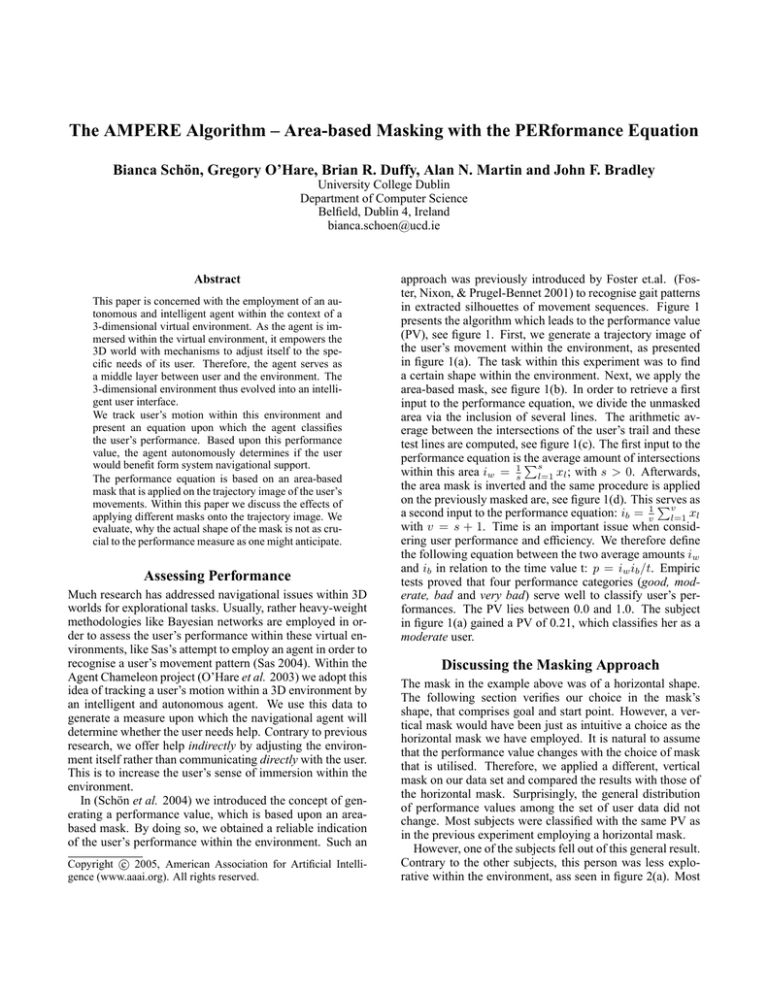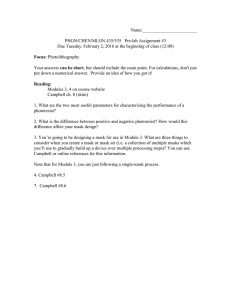
The AMPERE Algorithm – Area-based Masking with the PERformance Equation
Bianca Schön, Gregory O’Hare, Brian R. Duffy, Alan N. Martin and John F. Bradley
University College Dublin
Department of Computer Science
Belfield, Dublin 4, Ireland
bianca.schoen@ucd.ie
Abstract
This paper is concerned with the employment of an autonomous and intelligent agent within the context of a
3-dimensional virtual environment. As the agent is immersed within the virtual environment, it empowers the
3D world with mechanisms to adjust itself to the specific needs of its user. Therefore, the agent serves as
a middle layer between user and the environment. The
3-dimensional environment thus evolved into an intelligent user interface.
We track user’s motion within this environment and
present an equation upon which the agent classifies
the user’s performance. Based upon this performance
value, the agent autonomously determines if the user
would benefit form system navigational support.
The performance equation is based on an area-based
mask that is applied on the trajectory image of the user’s
movements. Within this paper we discuss the effects of
applying different masks onto the trajectory image. We
evaluate, why the actual shape of the mask is not as crucial to the performance measure as one might anticipate.
Assessing Performance
Much research has addressed navigational issues within 3D
worlds for explorational tasks. Usually, rather heavy-weight
methodologies like Bayesian networks are employed in order to assess the user’s performance within these virtual environments, like Sas’s attempt to employ an agent in order to
recognise a user’s movement pattern (Sas 2004). Within the
Agent Chameleon project (O’Hare et al. 2003) we adopt this
idea of tracking a user’s motion within a 3D environment by
an intelligent and autonomous agent. We use this data to
generate a measure upon which the navigational agent will
determine whether the user needs help. Contrary to previous
research, we offer help indirectly by adjusting the environment itself rather than communicating directly with the user.
This is to increase the user’s sense of immersion within the
environment.
In (Schön et al. 2004) we introduced the concept of generating a performance value, which is based upon an areabased mask. By doing so, we obtained a reliable indication
of the user’s performance within the environment. Such an
c 2005, American Association for Artificial IntelliCopyright gence (www.aaai.org). All rights reserved.
approach was previously introduced by Foster et.al. (Foster, Nixon, & Prugel-Bennet 2001) to recognise gait patterns
in extracted silhouettes of movement sequences. Figure 1
presents the algorithm which leads to the performance value
(PV), see figure 1. First, we generate a trajectory image of
the user’s movement within the environment, as presented
in figure 1(a). The task within this experiment was to find
a certain shape within the environment. Next, we apply the
area-based mask, see figure 1(b). In order to retrieve a first
input to the performance equation, we divide the unmasked
area via the inclusion of several lines. The arithmetic average between the intersections of the user’s trail and these
test lines are computed, see figure 1(c). The first input to the
performance equation is the
Psaverage amount of intersections
within this area iw = 1s l=1 xl ; with s > 0. Afterwards,
the area mask is inverted and the same procedure is applied
on the previously masked are, see figure 1(d). This serves
Pv as
a second input to the performance equation: ib = v1 l=1 xl
with v = s + 1. Time is an important issue when considering user performance and efficiency. We therefore define
the following equation between the two average amounts iw
and ib in relation to the time value t: p = iw ib /t. Empiric
tests proved that four performance categories (good, moderate, bad and very bad) serve well to classify user’s performances. The PV lies between 0.0 and 1.0. The subject
in figure 1(a) gained a PV of 0.21, which classifies her as a
moderate user.
Discussing the Masking Approach
The mask in the example above was of a horizontal shape.
The following section verifies our choice in the mask’s
shape, that comprises goal and start point. However, a vertical mask would have been just as intuitive a choice as the
horizontal mask we have employed. It is natural to assume
that the performance value changes with the choice of mask
that is utilised. Therefore, we applied a different, vertical
mask on our data set and compared the results with those of
the horizontal mask. Surprisingly, the general distribution
of performance values among the set of user data did not
change. Most subjects were classified with the same PV as
in the previous experiment employing a horizontal mask.
However, one of the subjects fell out of this general result.
Contrary to the other subjects, this person was less explorative within the environment, ass seen in figure 2(a). Most
(a) Trajectory Image
(b) Area-Based Mask
(c) Retrieving Intersections
(d) Inverting Mask
Figure 1: Graphical Presentation of the Masking Process on a moderate Performance
of his actions are focused on the area that is enclosed by the
vertical mask, see figure 2(b). The horizontal mask calculated a PV of 0.2, which renders him as a moderate user,
whereas the vertical mask classifies him as a good user, with
a PV of 0.03. This result might lead to the conclusion that
the shape of the mask depends on the explorational attitude
of each user. As the agent is unable to predict such behaviour, the mask would proof not generally applicable. However, this performance value only represents offline evaluation. In the experimental scenario, the agent accumulates
the performance measure online for each time step.
our performance equation and discussed different kinds of
area-based masks in order to generate a performance value.
Interestingly, changing the shape of the mask did not have
a decisive impact on the classification of the user performance. Limitations of this approach are that the agent has to
have knowledge about the dimensions of the environment.
The layout of rooms, doors and objects is not considered
here. Further research has to determine whether it is beneficial for the overall performance evaluation or if it occupies
too much computational resources without the benefit of a
higher level of accuracy.
Acknowledgement
The Agent Chameleon project is a collaborative project undertaken by the Department of Computer Science, University College Dublin and Media Lab Europe, Dublin. We
gratefully acknowledge the financial support of the Higher
Research Authority (HEA), Irleand. Gregory O’Hare gratefully acknowledges the support of Science Foundation Ireland under Grant No. 03/IN.3/1361/
(a) Trajectory Image
(b) Vertical Mask
As the shape of the horizontal and vertical masks do not
result in the same performance value, the next suggestion
would be to combine the two masks. This would result in
a mask that forms a square around the start and goal point
and excludes the rest of the environment. However, we do
not commission the use of such a mask as it heavily restricts the area. This forces the performance equation into
an unbalance state. In order to compensate this, the components that constitute the performance equation would need to
be weighted. Considering the relatively small benefit from
these adjustments and the already high accuracy of the performance equation with the presented type of mask, we do
not recommend this approach.
Conclusion
Within this paper we have described an area-based masking approach in order to gain information about user performances within a 3-dimensional environment. We described
References
Foster, J. P.; Nixon, M. S.; and Prugel-Bennet, A. P. 2001.
Recognising movement and gait by masking functions. In
Proceedings of Audio-Visual Biometric Person Authentication. Halmstadt, Sweden: Springer-Verlag.
O’Hare, G. M.; Duffy, B. R.; Bradley, J. F.; and Martin,
A. N. 2003. Agent chameleons: Moving minds from robots
to digital information spaces. In Procedings of Autonomous
Minirobots for Research and Edutainment (AMiRE) 2003.
Sas, C. 2004. Individual Differences in navigating and Experiencing Presence in Virtual Environments. Ph.D. Dissertation, Department of Computer Science, National University of Ireland, Dublin.
Schön, B.; O’Hare, G. M. P.; Duffy, B. R.; Martin, A. N.;
and Bradley, J. F. 2004. An agent-based approach to adaptive navigational support within 3d-environments. In Proceedings of the 2004 IEEE Conference on Cybernetics and
Intelligent Systems - CIS 2004.




